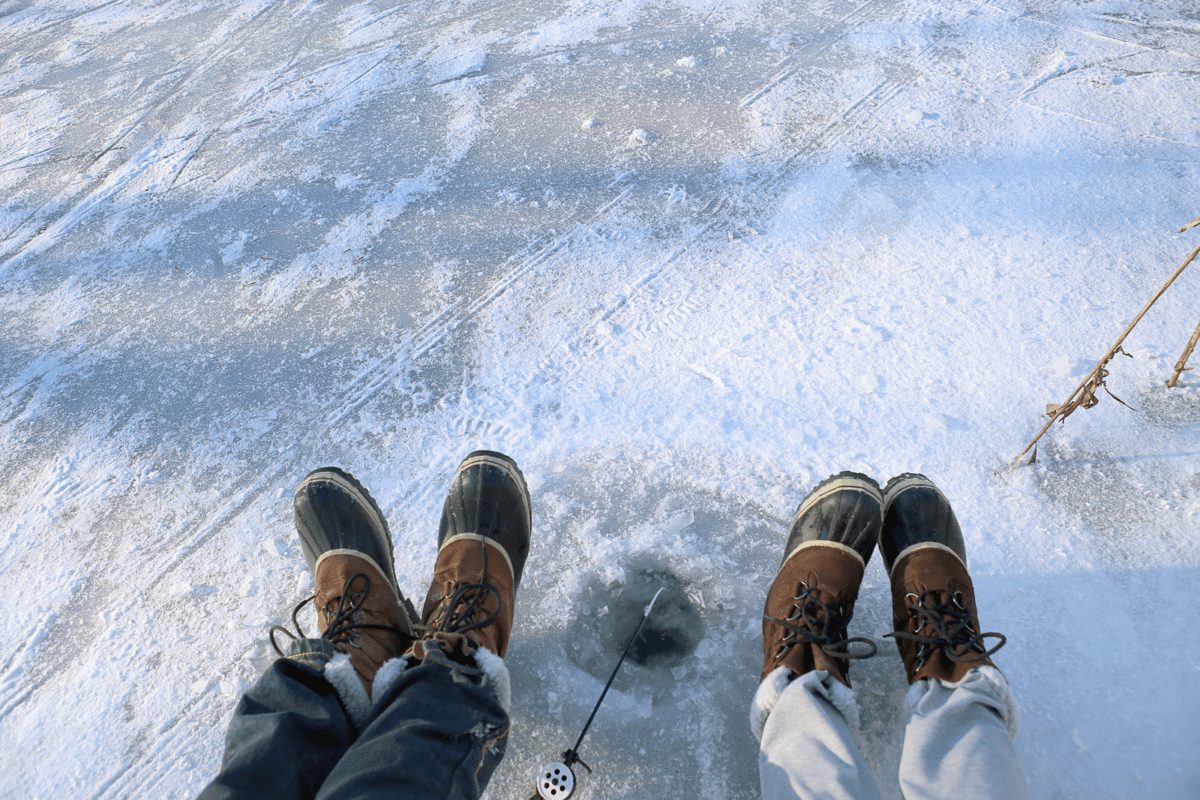Ice fishing is a long, cherished tradition in parts of the world that get cold enough to freeze over in the winter. Avoid getting yourself into trouble by following some basic safety guidelines and warmth suggestions.
How to Stay Safe On The Ice
Ice fishing is more safe than you might think but if you don’t follow some basic precautions you may find yourself in some trouble.
Before getting out on the ice, be sure to look up the weather for the day and, if you can, speak with the Ice Safety Specialist or a local fisherman! Each area of the world is different, no one will know the area better than them (plus, they might give you some good secret fishing spots).
Don’t Go Ice Fishing Alone
Though part of ice fishing allure (and that of fishing in general) is the solitude one finds by going out alone, when ice fishing it’s recommended to go with someone else or in a group in case of an emergency.
Pay Close Attention To Ice Thickness
Paying attention to the thickness of the ice you’ll be fishing is extremely important.
The thickness of the ice is extremely important to determining how safe it is to ice fish. As a general rule, avoid ice that has cracks or ice near inlets or moving water.
With an ice auger, make a hole in the ice deep enough to hit water. Hook the end of a tape measure on the edge and take the measurement. If you have any doubts the ice will hold, do not take the risk and don’t attempt to walk on the surface. The following measurements are a good rule of thumb to follow.
3 inches of ice is the bare minimum to walk on the lake. Spread out from other people, remain cautious, and recheck the ice thickness consistently. If you’re a larger person you may want to wait for 4 inches just in case.
4 inches of ice is pretty safe for a group of people on foot without any heavy machinery.
7 inches of ice is where you can start bringing things like an ATV out onto the ice but you’ll want to avoid anything heavier than that.
9 inches of ice can handle your car or a small pickup truck
12 inches of ice can handle just about any non-commercial vehicle. Just be smart about it, keep away from other vehicles and drive carefully.
It’s always best to drive very slowly, without making any abrupt turns, and without your seatbelt (you want to be able to get out of the car easily in a worst case scenario).
Safety Equipment
There are a few items you should bring along in case of an emergency.
A life vest or flotation suit is a must – in case you fall into the icy water you’ll be well served to not have to worry about drowning and you’ll be easier to pull out with the extra buoyancy.
Cleats or crampons are important to be able to walk on the ice without slipping. Obviously a slip on the ice could cause bodily harm but it’s also more likely than simply walking on the ice to cause a crack.
An ice pick is a handy item to have in case you do fall through the ice. Keep it on you at all times and, if you do fall through the ice, use the pick to get some leverage to pull yourself to safety.
It’s important to have a whistle so you can get others’ attention in case you or someone else are in trouble.
Ice fishing gear
How To Stay Warm (But Not Too Warm!)
It’s good to bundle up when you’ll be out in the snow and cold for hours. Failing to properly insulate can cause many health problems but running too hot is an often overlooked one.
Setting up your ice fishing gear can be a physically demanding task that can make you overheat, the sweat then dehydrating you and making you chill faster once seated or not moving.
It’s recommended that you “suit up” once you’ve made it to your destination and completed setting up your gear.
What to Wear While Fishing
Layering is key when spending extended time in the freezing cold temperatures. Layering makes it so that you are protected against the elements but also gives you the option of adding or subtracting smaller layers for more control over your own temperature.
Thermal clothing has modernized over the years in the outdoor fishing and hunting industry, with the many different kinds of materials with different benefits becoming available. Some companies have designed ice fishing products with more material in areas that get the coldest, and less in areas that are the warmest to help fight cold and overheating.
A thermal base layer (thin but heat retaining long sleeve t-shirt), followed by another long sleeved shirt (with a slightly thicker material such as wool or dense cotton), then topped with a heavy insulated coat
is best.
One important but oftentimes overlooked item to wear would be tall, water resistant, slip resistant snow boots. Especially if the snow is persistent at the time. Wearing two pairs of thick socks is also recommended.
In Summary
Ice fishing is an interesting mix of the serenity of fishing, extreme weather and heightened risk. Be sure you are prepared properly for ice fishing before beginning your journey – knowledge, patience and good old fashioned common sense are key for your trip out onto the ice.


